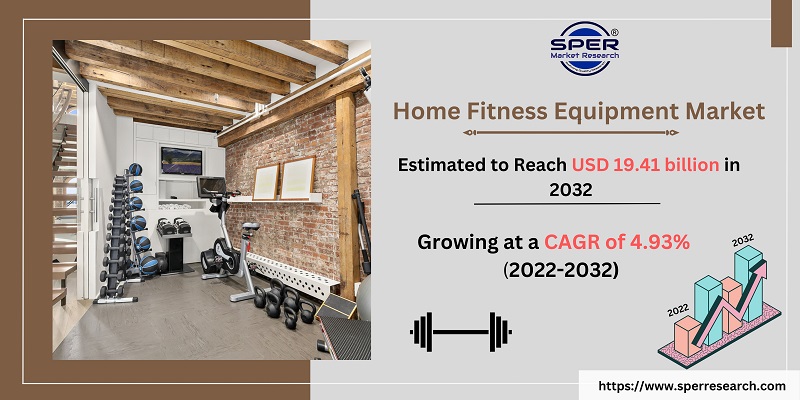
Home Fitness Equipment Market Growth, Revenue, Size, Share and Future Investment 2032
Home Fitness Equipment Market Size- By Product Type, By Grade, By Distribution Channel, By End User, By Training Type- Regional Outlook, Competitive Strategies and Segment Forecast to 2032
| Published: Mar-2023 | Report ID: MACH2316 | Pages: 1 - 228 | Formats*: |
| Category : Equipment and Machinery | |||


| Report Metric | Details |
| Market size available for years | 2019-2032 |
| Base year considered | 2021 |
| Forecast period | 2022-2032 |
| Segments covered | By Product Type, By Grade, By Distribution Channel, By End User, By Training Type |
| Regions covered | Asia-Pacific, Europe, Middle East & Africa, North America, Latin America |
| Companies Covered | Amer Sports Oyj, Corepump, HOIST Fitness Systems, ICON Health & Fitness Inc., Johnson Health Tech. Co., Ltd., JTX Fitness, Keiser Corporation, Louis Vuitton, Nohrd, Nordic Track, Peloton, Precor Inc., ProForm, Schwinn, Technogym Spa, Tonal Systems Inc., True Fitness, Vectra Fitness, York Barbell |
- Barbells & Ladders
- Elliptical and Others
- Extension Machines
- Free Weights
- Low-end Products
- Mid-grade Products
- High-end Products
- Dealers
- Online Shops
- Specialty Stores
- Other Distribution Channels
- Apartments
- Condos
- Houses
- Offices
- Cardiovascular Training Equipment
- Strength Training Equipment
- Others
- Asia-Pacific
- Europe
- Middle East & Africa
- North America
- Latin America
- Size of Global Home Fitness Equipment Market (FY'2019-FY'2032)
- Overview of Global Home Fitness Equipment Market
- Segmentation of Global Home Fitness Equipment Market By Product Type (Barbells & Ladders, Elliptical and Others, Extension Machines, Free Weights, Rowing Machines, Stationary Cycles, Treadmills, Other Training Equipment)
- Segmentation of Global Home Fitness Equipment Market By Grade (Low-end Products, Mid-grade Products, High-end Products)
- Segmentation of Global Home Fitness Equipment Market By Distribution Channel (Dealers, Online Shops, Retail Stores, Specialty Stores, Other Distribution Channels)
- Segmentation of Global Home Fitness Equipment Market By End User (Apartments, Condos, Houses, Offices, Small Gyms, Town homes, Other End Users)
- Segmentation of Global Home Fitness Equipment Market By Training Type (Cardiovascular Training Equipment, Strength Training Equipment, Others)
- Statistical Snap of Global Home Fitness Equipment Market
- Growth Analysis of Global Home Fitness Equipment Market
- Problems and Challenges in Global Home Fitness Equipment Market
- Competitive Landscape in the Global Home Fitness Equipment Market
- Impact of COVID-19 and Demonetization on Global Home Fitness Equipment Market
- Details on Recent Investment in Global Home Fitness Equipment Market
- Competitive Analysis of Global Home Fitness Equipment Market
- Major Players in the Global Home Fitness Equipment Market
- SWOT Analysis of Global Home Fitness Equipment Market
- Global Home Fitness Equipment Market Future Outlook and Projections (FY'2019-FY'2032)
- Recommendations from Analyst
1.1. Scope of the report1.2. Market segment analysis
2.1 Research data source
2.1.1 Secondary data2.1.2 Primary data2.1.3 SPER’s internal database2.1.4 Premium insight from KOL’s
2.2 Market size estimation
2.2.1 Top-down and Bottom-up approach
2.3 Data triangulation
4.1. Driver, Restraint, Opportunity and Challenges analysis
4.1.1 Drivers4.1.2 Restraints4.1.3 Opportunities4.1.4 Challenges
4.2. COVID-19 Impacts of the Global Home Fitness Equipment Market
5.1. SWOT analysis
5.1.1 Strengths5.1.2 Weaknesses5.1.3 Opportunities5.1.4 Threats
5.2. PESTEL analysis
5.2.1 Political landscape5.2.2 Economic landscape5.2.3 Social landscape5.2.4 Technological landscape5.2.5 Environmental landscape5.2.6 Legal landscape
5.3. PORTER’S five forces analysis
5.3.1 Bargaining power of suppliers5.3.2 Bargaining power of Buyers5.3.3 Threat of Substitute5.3.4 Threat of new entrant5.3.5 Competitive rivalry
5.4. Heat map analysis
6.1. Global Home Fitness Equipment Base Distribution, Sales Area, Product Type6.2. Mergers & Acquisitions, Partnerships, Product Launch, and Collaboration in Global Home Fitness Equipment Market
7.1. Barbells & Ladders7.2. Elliptical and Others7.3. Extension Machines7.4. Free Weights7.5. Rowing Machines7.6. Stationary Cycles7.7. Treadmills7.8. Other Training Equipment
8.1. Low-end Products8.2. Mid-grade Products8.3. High-end Products
9.1. Dealers9.2. Online Shops
9.2.1. Direct Online Stores9.2.2. Third Party Websites
9.3. Retail Stores9.4. Specialty Stores9.5. Other Distribution Channels
10.1. Apartments10.2. Condos10.3. Houses10.4. Offices10.5. Small Gyms10.6. Town homes10.7. Other End Users
11.1. Cardiovascular Training Equipment11.2. Strength Training Equipment11.3. Others
12.1. Global Home Fitness Equipment Market Size and Market Share by Region (2019-2025)12.2. Global Home Fitness Equipment Market Size and Market Share by Region (2026-2032)12.3. Asia-Pacific
12.3.1. Australia12.3.2. China12.3.3. India12.3.4. Japan12.3.5. South Korea12.3.6. Rest of Asia-Pacific
12.4. Europe
12.4.1. France12.4.2. Germany12.4.3. Italy12.4.4. Spain12.4.5. United Kingdom12.4.6. Rest of Europe
12.5. Middle East & Africa
12.5.1. Kingdom of Saudi Arabia12.5.2. United Arab Emirates12.5.3. Rest of Middle East & Africa
12.6. North America
12.6.1. Canada12.6.2. Mexico12.6.3. United States
12.7. Latin America
12.7.1. Argentina12.7.2. Brazil12.7.3. Rest of Latin America
13.1. Amer Sports Oyj
13.1.1. Company details13.1.2. Financial outlook13.1.3. Product summary13.1.4. Recent developments
13.2. Corepump
13.2.1. Company details13.2.2. Financial outlook13.2.3. Product summary13.2.4. Recent developments
13.3. HOIST Fitness Systems
13.3.1. Company details13.3.2. Financial outlook13.3.3. Product summary13.3.4. Recent developments
13.4. ICON Health & Fitness Inc.
13.4.1. Company details13.4.2. Financial outlook13.4.3. Product summary13.4.4. Recent developments
13.5. Johnson Health Tech. Co., Ltd.
13.5.1. Company details13.5.2. Financial outlook13.5.3. Product summary13.5.4. Recent developments
13.6. JTX Fitness
13.6.1. Company details13.6.2. Financial outlook13.6.3. Product summary13.6.4. Recent developments
13.7. Keiser Corporation
13.7.1. Company details13.7.2. Financial outlook13.7.3. Product summary13.7.4. Recent developments
13.8. Louis Vuitton
13.8.1. Company details13.8.2. Financial outlook13.8.3. Product summary13.8.4. Recent developments
13.9. Nohrd
13.9.1. Company details13.9.2. Financial outlook13.9.3. Product summary
13.9.4. Recent developments
13.10. Nordic Track
13.10.1. Company details13.10.2. Financial outlook13.10.3. Product summary13.10.4. Recent developments
13.11. Peloton
13.11.1. Company details13.11.2. Financial outlook13.11.3. Product summary13.11.4. Recent developments
13.12. Precor Inc.
13.12.1. Company details13.12.2. Financial outlook13.12.3. Product summary13.12.4. Recent developments
13.13. ProForm
13.13.1. Company details13.13.2. Financial outlook13.13.3. Product summary13.13.4. Recent developments
13.14. Schwinn
13.14.1. Company details13.14.2. Financial outlook13.14.3. Product summary13.14.4. Recent developments
13.15. Technogym Spa
13.15.1. Company details13.15.2. Financial outlook13.15.3. Product summary13.15.4. Recent developments
13.16. Tonal Systems Inc.
13.16.1. Company details13.16.2. Financial outlook13.16.3. Product summary13.16.4. Recent developments
13.17. True Fitness
13.17.1. Company details13.17.2. Financial outlook13.17.3. Product summary13.17.4. Recent developments
13.18. Vectra Fitness
13.18.1. Company details13.18.2. Financial outlook13.18.3. Product summary13.18.4. Recent developments
13.19. York Barbell
13.19.1. Company details13.19.2. Financial outlook13.19.3. Product summary13.19.4. Recent developments
SPER Market Research’s methodology uses great emphasis on primary research to ensure that the market intelligence insights are up to date, reliable and accurate. Primary interviews are done with players involved in each phase of a supply chain to analyze the market forecasting. The secondary research method is used to help you fully understand how the future markets and the spending patterns look likes.
The report is based on in-depth qualitative and quantitative analysis of the Product Market. The quantitative analysis involves the application of various projection and sampling techniques. The qualitative analysis involves primary interviews, surveys, and vendor briefings. The data gathered as a result of these processes are validated through experts opinion. Our research methodology entails an ideal mixture of primary and secondary initiatives.



Frequently Asked Questions About This Report
PLACE AN ORDER
Year End Discount
Sample Report
Pre-Purchase Inquiry
NEED CUSTOMIZATION?
Request CustomizationCALL OR EMAIL US
100% Secure Payment






Related Reports
Our Global Clients
Our data-driven insights have influenced the strategy of 200+ reputed companies across the globe.




















